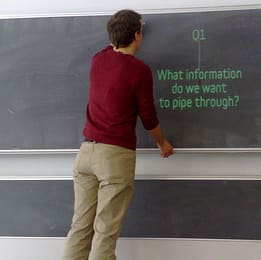
Spending the morning in a workshop (actual title: “Help us design a new type of web tool to manage presence, feeds, flow, activity and peripheral awareness (with added GTD!)”) lead by Lee Bryant and a team of Headshift fellows.
This is a three-hour workshop, so I guess I'll just take notes, comment and save every now and then.. we'll see how this works out.
Ok, so we got through the advertisement part (“we apply emergent social software ideas to the real-world ideas of large organizations”, basically the usual “burried-in-my-inbox”, “more flow”, “more sharing”, etc.) we get some sort of a briefing (sidenote: the Apple Keynote presentation style is rapidly becoming as tired and démodé as the PPT classics.. while writing this the guy switches to using the blackboard, well done!), followed by a classification of existing basic tools (email, micro/blogging, GTD tools, feed readers, social bookmarking, twitter, dopplr.. ) into an axis schema of info/action and low/high persistence and engagement. The plan seems to be to switch from this rather abstract level directly to collecting features afterwards, without going through personas, user stories and all that UCD stuff.
So far it looks like they intend to use as expert brain storming partners instead of educated users (in a User Innovation type of mode), which probably makes sense with the audience at hand.
Next part on “Social tools and Decision Making” – do these tools favour a certain type of decision making, changing the process? Does information get distributed to your peer group / competition faster and more evenly? Or is there just more noise, and deciding is basically filtering, constantly adjusting your trust levels and relevance meters? What about all those history of decision support systems be forgot?
then presents the RPD model, that's interesting. The pattern recognition part of that certainly is the most undersupported part of the usual social software stack – collaborative filtering seems not enough. Somebody should invite one of those companies doing sentiment detection/analysis on blogs etc. Visualizing patterns would help a lot, too. Who does that?
And then.. features. What can actually be done (by Headshift ;-)) at this moment, concretely. Discussion in 4 groups, each with a question (playing scribe here):
- Q1: What information do we want to pipe through such an app?
- Group says: wrong question :)
- Basically anything..
- But switchable according to current personal mode/context
- Q2: How do we want to access and transform this information?
- Ranking/correlate with/by action of emergent peer groups, implicit and explicit (“attention metadata”)
- Multiview/multimode
- Q3: What sort of global actions do we need to support (our group :))
- Collect/Organize/Prioritize/Process
- Relate
- Assign to Persons/Time/Place
- Forget/Postpone
- Q3: What would be the key features of the tool?
- Adaptive, personalizable interface(s)
- Self-learning
- Enable and facilitate action
- Desktop integration
- Microformat/Semantics aware..
Aha.. Lotus Notes++ anybody? Do we really need more than an inbox that's a little bit more clever? Never mind, next is designing an interface! Suggestions: Just a search box, plus some lenses. Or something just like Finder, but a little more clever. Or something like your MUA/PIM (Outlook..) – just a little bit more clever. Somebobdy said a command line. Or make it an actual -adaptive- device. “Simplexity”.. or basically: separate service from interface. I'd say just go finally really leverage email.
New people I got to know in the group discussions: Philipp Schroeder, Luca Mascaro.
Picture from the event are slowly coming in, too. I'll try to find my hotel and will be back for Nicolas' ubicomp session. See you.
